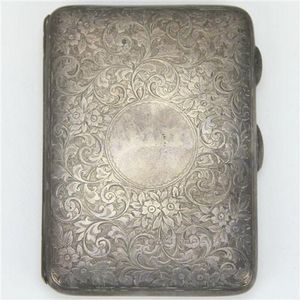Floral Etched Sterling Silver Pocket Notebook with Pencil
You must be a subscriber, and be logged in to view price and dealer details.
Subscribe Now to view actual auction price for this item
When you subscribe, you have the option of setting the currency in which to display prices to $Au, $US, $NZ or Stg.
- Sterling Silver - Sterling silver is a mixture of 92.5% pure silver and 7.5% of another metal, usually copper. Fine silver is 99.9% pure silver, and is relatively soft and the addition of the very small amount of copper gives the metal enough strength and hardness to be worked into jewellery, decorative and household objects.
- Edward Vii - Edward VII (1841 ? 1910) was King of the United Kingdom and the British Dominions and Emperor of India from 1901 until his death in 1910. He was the first British monarch of the House of Saxe-Coburg and Gotha, which was renamed the House of Windsor by his son, George V.
- Ivory - Ivory is a hard white material that comes from the tusks of elephants, mammoth, walrus and boar, or from the teeth of hippopotamus and whales. The ivory from the African elephant is the most prized source of ivory. Although the mammoth is extinct, tusks are still being unearthed in Russia and offered for sale.
Ivory has been used since the earliest times as a material for sculpture of small items, both in Europe and the east, principally China and Japan.
In Asia ivory has been carved for netsuke, seals, okimono, card cases, fan supports, animals and other figures and even as carved tusks.
In the last 200 years in Europe ivory has been used to carve figures, for elaborate tankards, snuff boxes, cane handles, embroidery and sewing accessories, in jewellery and as inlay on furniture. Its more practical uses include being used for billiard balls, buttons, and a veneers on the top of piano keys.
The use and trade of elephant ivory have become controversial because they have contributed to Due to the decline in elephant populations because of the trade in ivory, the Asian elephant was placed on Appendix One of the Convention on International Trade in Endangered Species (CITES), in 1975, and in January 1990, the African elephant was similarly listed. Under Appendix One, international trade in Asian or African elephant ivory between member countries is forbidden. Unlike trade in elephant tusks, trade in mammoth tusks is legal.
Since the invention of plastics, there have been many attempts to create an artificial ivory - Cartouche - An ornamental panel in the form of of a shield, oval or rectangular scroll with curling edges. It may be carved into the back of a chair or the top of a sideboard, or present on a piece of silver or jewellery, and contain the initials of the original owner, heraldic symbols, or some other inscription, such as the details of a presentation.
In ceramics the term defines the central area of a vase or similar with a decorative border in one of the shapes above, into which a decorative scene or figures have been painted.
This item has been included into following indexes:
Visually similar items

English hallmarked sterling silver Edward VII calling card case having a rectangular body with hand-engraved stag, floral & scroll decoration, a vacant central cartouche, & a side-hinged lid. Birmingham, 1901, maker Crisford & Norris Ltd. Length 10 cm. Wei

English hallmarked sterling silver Victorian cigarette case having etched floral detail, a gilt wash interior & monogrammed 'Ach'. Birmingham, 1897, maker a & J Zimmerman Ltd. Condition good to fair, clasp slightly loose, age related wear, some tarnishing.

A late Victorian quality engraved silver cigarette case, shaped for the hip, all-over repeating fine scroll engraving of Persian inspired form, gilded interior. Birmingham 1889 by Howard James, a noted case maker

English hallmarked sterling silver George V cigarette case having a rectangular shaped body with rounded edges, hand-engraved floral decoration, central cartouche monogrammed 'Rj', a gilt wash interior & a thumb-piece with catch. Birmingham, 1916, maker Pa
